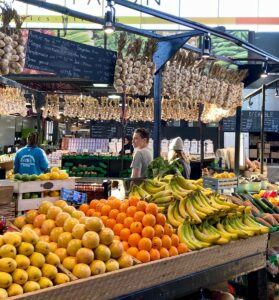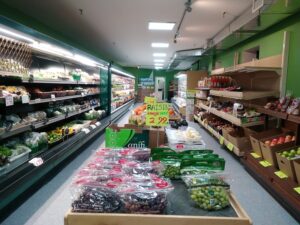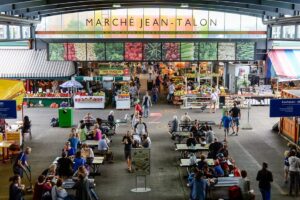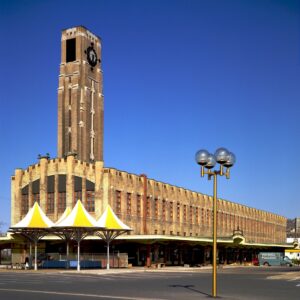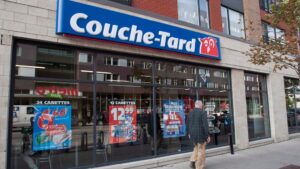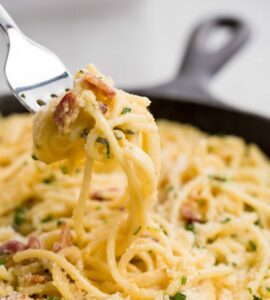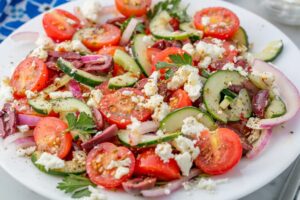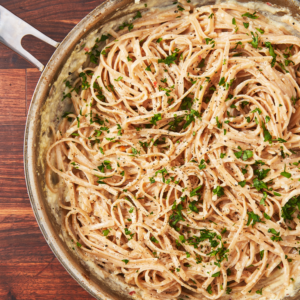For some, Montreal is the first time when grocery shopping has become a priority. If you’ve never lived on your own before and have had to shop and cook for yourself, the idea of moving to a new city in a different country and having to deal with groceries may seem a little daunting. The goal of this guide is to help those who want a little guidance or help those who just want to become a little more organized with their monthly spending. This is mostly focused on groceries and recipes, but along with this is a monthly budgeting worksheet that includes various areas of expenses, such as bills, clothing, etc.
Coming to a bustling city such as Montreal, it’s extremely tempting to go and try all of the great restaurants it has to offer. Foods from around the world are available, from tiny family-run businesses to large chains. As much as it’s highly encouraged to try new things, dining out isn’t the best for your wallet in the long run, so it’s important to give yourself a monthly limit (and stick to it). The best way to reduce stress about what and how you’re eating is to plan ahead and budget. Let’s go!
GROCERIES
As far as groceries go, there are so, so many options! Of course, there are the large chain grocery stores that will most likely have inexpensive items and big brands that show up all across North America, but there are several smaller markets and stores that have wonderful food and comparable prices, even though the quality would definitely be worth the slightly higher price tag.
- Adonis
Adonis was the first grocery store we were introduced to here in Montreal. The closest one is around .5 mile walk from Evo and has almost everything you’d need for a standard grocery trip. This group of stores started out as a small Lebanese store opened by immigrants in the 1970s and is now a set of supermarkets with popular deli counters.
- Marché K
Marché K isn’t a large chain of supermarkets, but it’s a small grocery store that’s just about a 5-minute walk from the Champlain Academic Center. From the outside, it doesn’t look like much besides a convenience store, but they have a pretty good selection of produce and snacks that come in handy for lunch or an after-class grocery run to pick up a few things.
- Provigo
Provigo is a large chain that tends to be slightly more pricey for an average college student shop, as they often sell higher-end brands, though the quality is there to match. There is a Provigo also somewhat near the residence, though most tend to favor Adonis prices.
- Jean-Talon Market
We were lucky enough to get to visit Jean-Talon for a class trip, but everyone should visit at least once during their time in Montreal, if not more frequently. It’s typically a large outdoor market, though in the winter it’s moved indoors and is much smaller. However, there are still amazing produce stalls and vendors of all different kinds. My personal favorite stops are the ice cream store, as well as the spice shop, which is full of any spices you’d ever need.
- Atwater
Similar to Jean-Talon, Atwater is an indoor/outdoor market that changed with the seasons. There are plenty of vendors and restaurants to choose from, and with its position near the water, it makes a lovely stop after a stroll (though in winter it may be a bit chilly for that). Many people are fiercely loyal to either Jean-Talon or Atwater, but it is definitely possible to love both!
- IGA
“IGA (Independent Grocers Alliance) is the largest group of independent grocers in Canada. In Quebec, its presence dates to 1953, but it all started in 1873 with the opening of a fruit and vegetable store on Rue St-Paul in Montreal.” IGA is a popular chain of grocery stores in Canada, with a few located in the U.S. Because of their popularity and growth, they definitely have a lot to offer to customers, though there aren’t any in the immediate vicinity of the Champlain Academic Center or Evo.
- Metro
Metro started as a small group of independent grocers who decided to band together to offer competitive prices to those of major food retailers and has now grown to have large stocks, as well as agreements with more independent sets of grocery stores, as well as pharmacies and convenience stores. As opposed to chains of identical stores, there are many different stores under the Metro name, so they may all be different, but there are many around to offer customers all sorts of products.
- Costco
Of course, you can only go to Costco if you or a friend has a Costco membership. And even then, you can only pay for things in Canada with a Costco credit card or cash. BUT! If you have a card, Costco is a wonderful place to go for things such as bulk snacks or toiletries. It’s a short bus ride away from Evo, and if you’re okay with bringing reusable bags and carrying things on the bus or an Uber, it can be very beneficial to look into going.
CONVENIENCE STORES (DEPANNEURS)
- Couche-Tard
Couche-Tard is a major convenience store chain, of which there are several around Evo. Hours depend on each store, but there is a 24-hour one a couple of blocks away from Evo/the entrance to the Square Victoria Metro station. They usually have coffee and snacks, candy, and beer/wine (though alcohol cannot be bought after 11 pm).
- Depanneurs
“Depanneur” is the term used to describe general convenience stores, but it is also so much more than that. The culture of depanneurs in Montreal goes back years and years. They’re not a chain, though Couche-Tard falls under the category of depanneur. Instead, they’re mostly independently run small businesses that you can find on almost every block, and can usually depend on for most hours of the day. Depanneurs are extremely popular with Quebecers, especially since they were the first type of store to be open at night and on Sundays, as well as small stores that weren’t government-operated and allowed to sell alcohol. It’s worth knowing something about the history of depanneurs as a part of the culture in Montreal, and probably handy to know the locations of those closest to you!
EASY RECIPES
These are just a few recipes that I’ve found are easy and relatively inexpensive to make. I have no affiliation with the sites that I’ve found them on, just ones that I personally enjoy!
- Chicken Fajitas
Chicken and bell peppers tend to be inexpensive, and that means you can make food in bulk and have some for leftovers! Save any leftovers in containers and heat up tortillas whenever you’re hungry again. Recipe here.
- Spaghetti Carbonara
Spaghetti is usually an easy staple food that we learn how to cook fairly early on. Carbonara is a little step up from simple spaghetti and marinara, and instead involves bacon, eggs, and cheese. It’s yummy and creamy and doesn’t take long to make at all. Recipe here.
- Greek Salad
Most salads are pretty easy and inexpensive to make, but they can get pretty repetitive and boring. This salad is good for changing it up, or for those people who don’t love typical leafy salad. It’s a light and refreshing option for a side dish or the main meal. Recipe here.
- “Skinny” Alfredo Pasta
If you’re looking for easy recipes that are also healthier versions of comfort foods, this alfredo recipe is lighter and uses whole wheat pasta instead of normal pasta. Recipes like this can be easily added to (like chicken) or have ingredients switched around to be gluten-free, etc. It’s also an easy food to feed a group or provide leftovers. Recipe here.
- Sweet Potato & Chicken Curry
Curry can be a great option for making in bulk and eating as leftovers. If you can get your hands on some quality spices or curry pastes, even better. With all of the different markets around Montreal, there are plenty of small shops to look into and different spices to try. This is just one of the many curry options that are easy to make at home, and can easily be adjusted to be vegetarian or vegan. Recipe here.
- Chicken Thighs with Shallots & Spinach
Chicken thighs are super affordable and usually cheap to buy a lot of. There are many recipes out there that are great for different versions of fried or baked chicken thighs with various types of marinades or dressings. This is a super simple one-pan recipe that also adds some green to your plate. Recipe here.
PLACES TO FIND RECIPES
There are, of course, many places to find recipes for yourself. Before going abroad, consider figuring out what kind of food you want to cook (or learn how to cook), as well as what kinds of ingredients will be available to you!
- Family & Friends
Before you leave, it’s always good to ask your friends and family for any recipes you particularly love from home, if you don’t know them already. It’s helpful to be able to cook something familiar in a new place, as well as the fact that they’ll probably have some tips for you! Even if you don’t do this before leaving, shooting someone a message asking them for a recipe when you think of it is always still an option.
- Cookbooks
This one seems like a no-brainer, though with the internet and thousands of food websites at our fingertips, we generally don’t tend to turn to cookbooks as much, especially because they can get quite heavy. If you can, though, perhaps take the time to look through family cookbooks or those designated for types of food you particularly enjoy (or ones for how to cook on a budget!), and make photocopies or take photos to save for later.
- Websites
As I said, the internet is at our fingertips. You can search for pretty much any food and get some sort of recipe for it. There are usually dozens of variations and recommendations for substitutions if you have a dietary restriction or preference, so these can sometimes be the best go-to for those who need a little extra finessing of their meals. Websites I personally tend to enjoy include Bon Appetit, AllRecipes, Epicurious, etc.
- Youtube
Youtube can be a great place to look for step-by-step cooking videos, though sometimes they aren’t as detailed by themselves as a cookbook would be. However, most cooking channels usually add links to the recipes they’ve used in the description of the video, or have websites where you can find all of their recipes. Channels I recommend are (again) Bon Appetit, Binging with Babish, Joshua Weissman, and Matty Matheson.
BUDGETING APPS/SHEETS
- Personal Budgeting Worksheet – Link
This sheet I did not make, however, I found it and used it for myself for a month and found it very helpful! Obviously, there are some categories that may not apply to us as college students. However, getting used to a bigger sheet may be helpful for the transition to living entirely on your own after college. You can download the spreadsheet or as I did, open it in Google Sheets for easy access and editing.
- Recipe Budgeting Worksheet/Tracker – Link
I did actually create this simple sheet – I use it to track how much (generally) a recipe costs me to make. It’s good to take a look at all of the ingredients beforehand, see what you have, what you don’t, and you can keep a record of how much each recipe costs you on average, depending on what you already own. This can be good when deciding what to eat for the week before going grocery shopping. If you want to take it one step further, you can always record and keep the general price of every ingredient on file too, to either put together or other recipes, or so you know how much it would cost to switch it out, etc. The link above allows you to access the spreadsheet, where you can make a copy and save it to your personal drive for editing and use.
- Mint – Link
I’ve personally used Mint before, and it’s a great (free) app if you like designating certain amounts each month and having it automatically calculate how much you’ve used by interacting with your bank account. It’s a reputable app that’s been recommended to me by a family member who is a financial planner, so if you’re comfortable sharing your bank information with the app, it can do much for you.
- You Need A Budget (YNAB) – Link
YNAB was brought to my attention by one of my co-Peer Finance Coaches, and it’s a more in-depth budgeting app/software. It can be a little intimidating at first, but luckily it comes with a 34-day free trial and a tutorial. You can also hook this up to your bank account, or enter information manually. To fully use it you do need to buy a subscription, which is $12 a month or $84 a year. If you find this software really handy and want to make the dive into detailed budgeting, it would be worth looking into (or budgeting for)!
(Check out the Reference Links section below for a longer list of free budgeting apps!)
SITES USED FOR REFERENCE INFORMATION
- https://moving2canada.com/grocery-shopping-in-montreal/
- https://www.mtl.org/en/what-to-do/food/atwater-market
- https://www.iga.net/en/contact/a_propos
- https://corpo.metro.ca/en/about-us/history.html
- https://blogue.quebecentete.com/style-de-vie-a-quebec/vive-le-depanneur-quebecs-convenient-stores/
- https://www.nationaldebtrelief.com/best-free-budgeting-apps/ *Budgeting App List
- https://www.epicurious.com/
- https://www.allrecipes.com/
- https://www.bonappetit.com/recipes
(Photo references linked either on the photos themselves or the articles they accompany)
